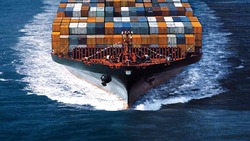World boxship fleet update: New orders emerge at end of extraordinary year

The sharp rebound in container shipping demand in the second half of 2020 encouraged the completion of orders that had been put on hold
While the world boxship fleet grew little in 2020, new orders in the final days of the year are unlikely to upset the supply and demand balance for now.
ORDERS for new containerships fell to their lowest levels in many years in 2020 despite a last minute rush to the yards in the closing days of the year.
Figures from Lloyd’s List Intelligence show that the global boxship fleet comprised 23.1m teu at the end of December, up by 577,179 teu since the start of the year.
“The global container fleet grew 2.9% in 2020, the lowest rate since 2016, further helping carriers in what was a tumultuous year,” Alphaliner said. “The capacity increase falls below predictions made at the start of the year, and marks the first time growth has dropped below 3% since 2016, when the container fleet expanded by just 1.8%.
“The fleet recorded growth of 4% in 2019.”
The coronavirus outbreak at the beginning of the year meant that many ordering decisions were put on hold as carriers and owners dealt with the initial fallout and collapse in demand.
Early indications were that the container shipping sector was about to have one of the worst years in its history, but a surprise boost in consumer demand in the second half of the year saw resurgent volumes that lines have struggled to transport.
That demand resilience has seen both non-operating owners and carriers return to the yards with much needed orders.
Hapag-Lloyd, the German carrier, had long been considered likely to add to its fleet after formalising no orders since 2016. In the final weeks of the year, the line finally confirmed it had ordered its first ultra-large tonnage.
The fifth-largest global carrier announced that the South Korean yard Daewoo Shipbuilding & Marine Engineering would build six 23,500-plus teu, dual-fuel boxships for around $1bn.
Deliveries are due between April and December 2023.
“The vessels will be deployed on the Europe–Far East routes as part of The Alliance and will significantly increase Hapag-Lloyd’s competitiveness in this trade,” Hapag-Lloyd said.
The new order came as chief executive Rolf Habben Jansen reiterated that the global containership orderbook, which he placed at 8% of today’s fleet, was too low.
“I am sure some orders will come in the foreseeable future,” he said. “That is also needed.”
The six-ship order on its own was too small to form its own Asia–Europe loop, so it was no surprise when The Alliance partner Ocean Network Express announced it had signed a long-term charter with Shoei Kisen Kaisha for six new ultra-large containerships too.
The vessels, which will be constructed by a Japanese consortium consisting of Imabari Shipbuilding and Japan Marine United, are due to be delivered in 2023/24, with a charter period of 15 years.
“This new class of ships will join our core fleet and forms part of our strategy to introduce large, modern, and fuel-efficient vessels to further strengthen our fleet competitiveness,” ONE said.
The new ships are expected to “help bring economies of scale and significantly lower carbon emissions through a state-of-the-art hull design that aims to maximize cargo intake and minimise fuel consumption”, it said, adding that the vessels will be equipped with exhaust gas cleaning systems to meet regulations.
In the final days of the year, the order spree was completed when Yangzijiang Shipbuilding said it had won orders for two 24,000 teu containerships, marking the biggest vessels in this segment that the Chinese builder has yet constructed.
The Singapore-listed company did not reveal the shipowner in the announcement but Bocomm Financial Leasing and Mediterranean Shipping Co are widely understood to be behind the newbuilding contract.
The deal comes on the heels of an order signed between the Chinese lessor and two yards under China State Shipbuilding Corp for four scrubber-fitted boxships of the same size, which were also linked to charters from the Geneva-based carrier.
News of MSC’s appetite for pursuing ultra-large fresh tonnage had been circulating in the market for a few months.
Like many of its competitors, MSC historically preferred to work with South Korean builders on its ultra-large containership newbuildings, with five of its previously ordered 23,000 teu vessels being constructed at Daewoo Shipbuilding & Marine Engineering.
Despite these orders, there are few concerns yet over a rush of ordering pushing capacity back above demand at the moment.
“A flurry of large containership order at the end of 2020 has increased the industry orderbook back to just over 10% of the fleet, although almost all were orders we already had anticipated would take place in either 2020 or 2021,” said analysts at Maritime Strategies International.
“Unless followed by similar volumes early in 2021, the industry’s favourable supply outlook remains intact.”
December deliveries saw another 80,000 teu added to the fleet, including the latest is CMA CGM’s series of LNG-fuelled ULCs, the 22,000 teu CMA CGM Louvre (IMO: 9839143).
Scrapping activity was expected to grow in early 2020, but the bounce back in demand has seen charter rates surge, even for older tonnage. For owners deciding whether to take a vessel out of commission, carrier willingness to pay over the odds for boxship capacity has swung the odds against removing tonnage.
“Deletions fell by just 1% to 205,447 teu during 2020,” Alphaliner said. “Once spot rates started to climb from June onwards, owners had no incentive to go to the scrapyards.”
Lloyd’s List Intelligence reported just one ship demolished in December, and that was nearly 40 years old.
The same demand keeping ships out of the yards could be seen in the falling size of the idle fleet, which Lloyd’s List Intelligence put at just 315,879 teu, or 1.4% of global fleet capacity. Of the 250 ships reported laid up in December, only 20 were more than 3,000 teu.